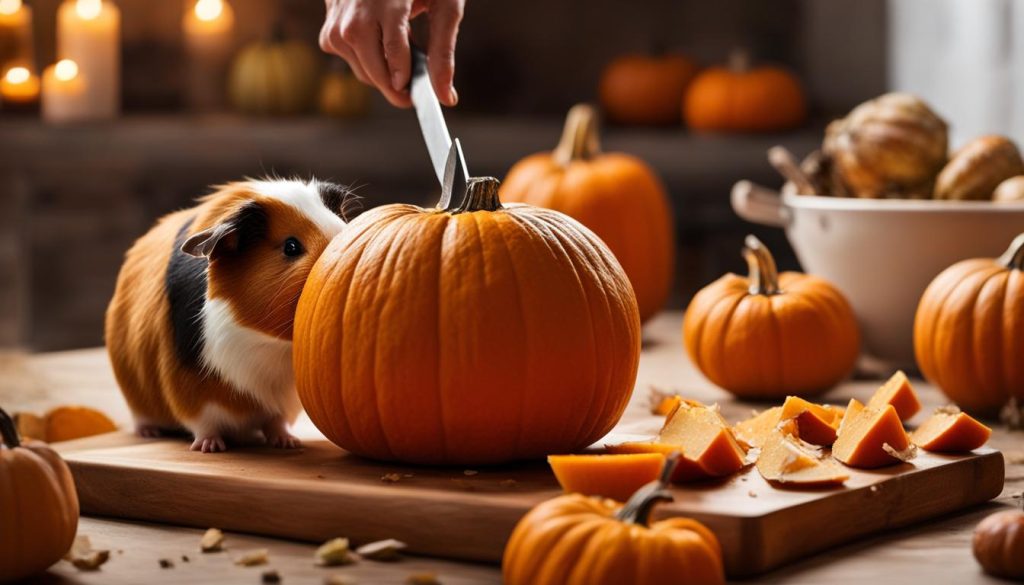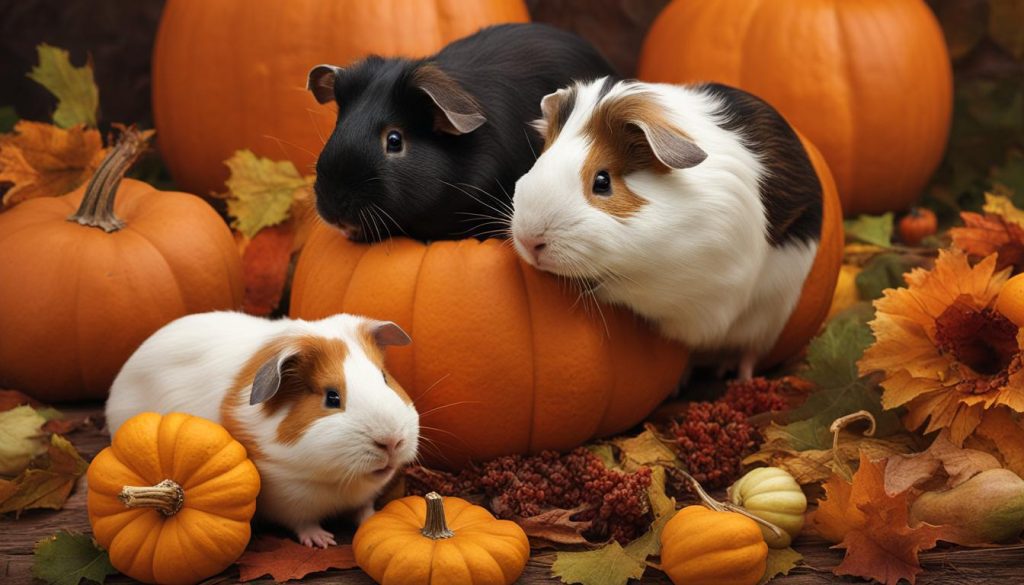As a guinea pig owner, you may be curious if it’s safe to feed pumpkin to your furry friend. Well, I’m here to provide you with all the information you need to know about including pumpkin in your guinea pig’s diet. So, let’s get started!
Can Guinea Pigs Eat Pumpkin? Yes, it’s perfectly okay!
- Guinea pigs can eat pumpkin as a treat, but it should be given in moderation.
- Pumpkin provides essential nutrients like vitamin A and vitamin C.
- Avoid feeding guinea pigs pumpkin seeds, as they can be a choking hazard and are high in fat.
- Excessive water and sugar content in pumpkins can lead to digestive issues in guinea pigs.
- Thoroughly clean and prepare pumpkin before serving it to your guinea pig.
Nutritional Benefits of Pumpkin for Guinea Pigs
Pumpkin offers a range of nutritional benefits that can positively impact the health of guinea pigs. One of the key advantages of feeding pumpkin to guinea pigs is its high content of vitamin A, which contributes to healthy eyesight and well-hydrated skin. This is particularly beneficial for hairless guinea pig breeds that are more prone to dry skin.
In addition to vitamin A, pumpkin is also a good source of vitamin C, which is essential for boosting the immune system and preventing scurvy in guinea pigs. Vitamin C plays a crucial role in collagen production, promoting wound healing, and supporting overall well-being.
Furthermore, pumpkin contains potassium, an essential mineral that aids in fluid regulation, nerve transmission, and muscle contraction. Potassium also helps to prevent osteoporosis and bladder stones, ensuring the overall health and well-being of guinea pigs.
While pumpkin offers these substantial nutritional benefits, it is important to note that it is not a significant source of vitamin C. Guinea pigs require a daily intake of vitamin C to maintain their health, and relying solely on pumpkin as a vitamin C supplement may not suffice. Therefore, it is recommended to provide additional sources of vitamin C, such as guinea pig pellets or fresh fruits and vegetables.
To visually demonstrate the nutritional benefits of pumpkin for guinea pigs, take a look at the table below:
Risks and Precautions of Feeding Pumpkin to Guinea Pigs
While pumpkin can be a safe treat for guinea pigs, it’s important to be aware of the risks and take necessary precautions to ensure their well-being. There are several factors to consider when feeding pumpkin to guinea pigs, including the dangers of pumpkin seeds, the water and sugar content in pumpkins, and the potential effects on their digestive system.
Pumpkin seeds: Feeding pumpkin seeds to guinea pigs can be dangerous due to the risk of choking. These small and hard seeds can easily get stuck in their throat, leading to respiratory distress. Additionally, pumpkin seeds are high in fat, which can be detrimental to guinea pigs’ health.
Water content: Pumpkins have a high water content, which can be problematic if overconsumed by guinea pigs. Excessive water intake can result in diarrhea, causing discomfort and dehydration in these small animals. It’s important to feed pumpkin in moderation and monitor their stool consistency closely.
Sugar content: Another aspect to consider is the sugar content in pumpkins. While guinea pigs enjoy the sweet taste, too much sugar can lead to constipation and obesity. These conditions can have negative impacts on their overall health and well-being.
It’s essential to feed pumpkin to guinea pigs in moderation and observe their response. Starting with small amounts once or twice a week is recommended. This allows you to gauge how their body reacts to pumpkin and adjust the serving size accordingly. Monitoring their stool consistency is crucial to ensure they are digesting the pumpkin properly.
If your guinea pig experiences any digestive issues or abnormal symptoms after consuming pumpkin, it’s important to consult a veterinarian. They can provide professional advice and guidance specific to your pet’s needs.
Guinea Pigs’ Preference for Pumpkin
Like humans, guinea pigs have a natural fondness for sweet treats, and pumpkin is no exception. These adorable rodents generally enjoy the taste of pumpkin and can be easily enticed by its unique flavor.
When offering pumpkin to your guinea pig, you may find that they eagerly nibble on it, savoring every bite. The mild sweetness and soft texture of pumpkin make it a delightful addition to their diet and a scrumptious treat for them to enjoy.
However, it’s important to remember that each guinea pig has its own individual preferences. While many guinea pigs may love the taste of pumpkin, some may show a preference for other treats or may not be as interested in pumpkin flavor. Therefore, it’s essential to pay attention to their response and adjust the serving size accordingly.
Observing your guinea pig’s behavior and reaction to pumpkin can give you valuable insights into their preferences. If they seem particularly excited and eager to munch on pumpkin, it’s a good indication that they enjoy the taste. On the other hand, if they show less interest or seem indifferent, you may need to explore other flavors and treats that better suit their preferences.
Remember to incorporate variety into their diet and offer a range of healthy, guinea pig-safe treats. This will not only ensure they receive balanced nutrition but also give them the opportunity to indulge in different flavors and textures.
How to Prepare and Serve Pumpkin to Guinea Pigs
To ensure that pumpkin is safe and enjoyable for your guinea pigs, proper preparation and serving techniques are essential. Here’s a step-by-step guide:
Cleaning the Pumpkin
Start by thoroughly cleaning the pumpkin to remove any dirt or germs. This can be done by rinsing it under running water and using a vegetable brush to scrub away any impurities.
Serving the Pumpkin
Pumpkin can be served to guinea pigs with the rind and flesh intact. However, if your guinea pig dislikes the skin, it’s best to remove it before serving.
Thin slices or bite-sized cubes are the ideal size for guinea pigs to handle and consume easily. Be sure to remove all the seeds, as they pose a choking hazard.
Frequency and Serving Size
Guinea pigs should be given two to three small pieces of pumpkin once or twice a week. Monitor your guinea pig’s response and stool consistency to determine the optimal serving size for them.
If your guinea pig experiences any digestive issues, such as diarrhea or constipation, it’s important to adjust the serving size accordingly.
Remember, moderation is key when serving pumpkin to guinea pigs.
Removing Leftover Pumpkin
Any uneaten pumpkin should be removed from the cage within a few hours to prevent spoilage. This will help maintain a clean and hygienic environment for your guinea pigs.

By following these steps, you can ensure that your guinea pigs enjoy their pumpkin treats safely and with the proper serving size. Keep in mind that every guinea pig is unique, so adjust the serving size based on their individual needs and responses.
Other Safe Foods for Guinea Pigs
Along with pumpkin, there are several other safe foods that can be included in a guinea pig’s diet. Guinea pigs require a well-rounded diet consisting of hay, high-quality guinea pig pellets, and fresh leafy vegetables.
Safe vegetables for guinea pigs include bell peppers, cucumbers, carrots, and romaine lettuce. These vegetables provide essential vitamins and minerals, promoting overall health and well-being.
Safe fruits for guinea pigs include strawberries, watermelon, and apples (without seeds). These fruits offer a tasty and nutritious treat, rich in vitamins and antioxidants.
When introducing new foods to a guinea pig’s diet, it’s important to do so gradually. This allows their digestive system to adjust and minimizes the risk of gastrointestinal upset. It’s also crucial to monitor the guinea pig’s response to the new foods, ensuring they tolerate them well and don’t experience any adverse reactions.
I love providing a varied diet for my guinea pig, and I always make sure to include a mix of safe vegetables and fruits. The vibrant colors and different textures make mealtime more exciting for my furry friend. Remember, a happy and healthy guinea pig starts with a nutritious and diverse diet!
Foods to Avoid Feeding Guinea Pigs
When it comes to feeding guinea pigs, there are certain foods that should be avoided. It’s important to be aware of these unsafe foods to ensure the well-being and health of your furry friends.
Avocado

Avocado is toxic to guinea pigs and should never be fed to them. The skin, leaves, and pit of the avocado contain a substance called persin, which can be harmful to guinea pigs and other small pets. It can lead to symptoms such as difficulty breathing, fluid accumulation in the chest, and even death. To keep your guinea pig safe, always keep avocado away from them.
Raisins and Dates
Raisins and dates are high in sugar and can cause digestive problems for guinea pigs if consumed in large quantities. These sweet treats may lead to diarrhea and upset stomachs in guinea pigs. It’s best to avoid feeding raisins and dates to your furry friends to prevent any potential health issues.
Olives
While olives may be a delicious treat for us, they are not suitable for guinea pigs. Olives are high in fat and sodium, which can be detrimental to the health of guinea pigs. Feeding olives to guinea pigs can lead to weight gain, heart issues, and other health complications. It’s best to steer clear of olives when it comes to feeding your guinea pig.
Spicy Peppers
Spicy peppers, such as jalapeno, can irritate the sensitive digestive system of guinea pigs. These peppers contain capsaicin, which can cause discomfort and digestive upset in guinea pigs. It’s important to avoid feeding any spicy peppers to your guinea pig to prevent any potential health issues.
Conclusion
Feeding pumpkin to guinea pigs can be a safe and enjoyable addition to their diet when done in moderation. Pumpkin contains essential vitamins and nutrients, such as vitamin A and C, that can benefit their overall health. However, it’s important to remember that pumpkin should not be relied upon as the sole supplement for these nutrients. Guinea pig owners should ensure a balanced diet that includes hay, pellets, and fresh leafy vegetables alongside pumpkin treats.
When feeding pumpkin to guinea pigs, it’s crucial to be aware of the risks and take necessary precautions. Avoid giving them pumpkin seeds as they can pose a choking hazard and have a high fat content. Additionally, monitor the water and sugar intake as excessive consumption can lead to digestive issues like diarrhea, constipation, and even obesity.
By following the proper guidelines, such as serving small amounts of cleaned pumpkin and adjusting the portion based on the guinea pig’s response, owners can safely incorporate this sweet treat into their pets’ diet. Always consult a veterinarian if any unusual symptoms or digestive issues arise. Remember, a healthy and happy guinea pig is a well-nourished one!
FAQ
Can guinea pigs eat pumpkin?
Yes, guinea pigs can eat pumpkin as a treat.
Is pumpkin safe for guinea pigs?
Yes, pumpkin is safe for guinea pigs, but it should be given in moderation.
What are the benefits of feeding pumpkin to guinea pigs?
Pumpkin contains vitamin A, which promotes eye health and skin hydration, and vitamin C, which boosts the immune system. It also provides potassium to regulate fluids and prevent bladder stones.
Can guinea pigs eat pumpkin seeds?
No, guinea pigs should not eat pumpkin seeds due to the risk of choking and high fat content.
How should I prepare and serve pumpkin to my guinea pigs?
Thoroughly clean the pumpkin, remove the seeds, and serve the pumpkin with the rind and flesh. Thin slices or bite-sized cubes can be offered to guinea pigs.
How much pumpkin can I feed my guinea pigs?
Guinea pigs should be given small amounts of pumpkin once or twice a week. The serving size can be adjusted based on their response and stool consistency.
Can guinea pigs have pumpkin as a daily treat?
No, pumpkin should be given in moderation, and it should not be a daily treat for guinea pigs.
What are some alternatives to pumpkin for guinea pigs?
Some alternatives to pumpkin for guinea pigs include bell peppers, cucumbers, carrots, strawberries, watermelon, and apples (without seeds).
Can guinea pigs be allergic to pumpkin?
Guinea pigs can develop allergies to certain foods, including pumpkin. Monitor your guinea pig’s response after introducing pumpkin and consult a veterinarian if any allergic reactions occur.
What are the risks of feeding pumpkin to guinea pigs?
The excessive water and sugar content in pumpkins can lead to diarrhea, constipation, and obesity in guinea pigs. It’s important to feed pumpkin in moderation and monitor the guinea pig’s response and stool consistency.
What other foods should I avoid feeding my guinea pigs?
Avoid feeding guinea pigs avocado, raisins, dates, olives, and spicy peppers, as these foods can be harmful to their health.






